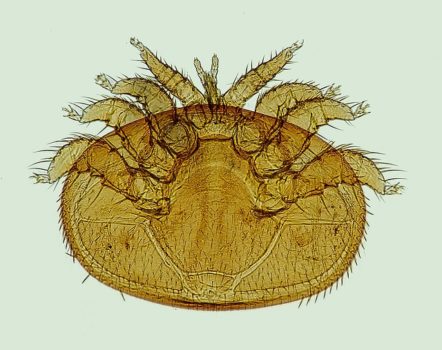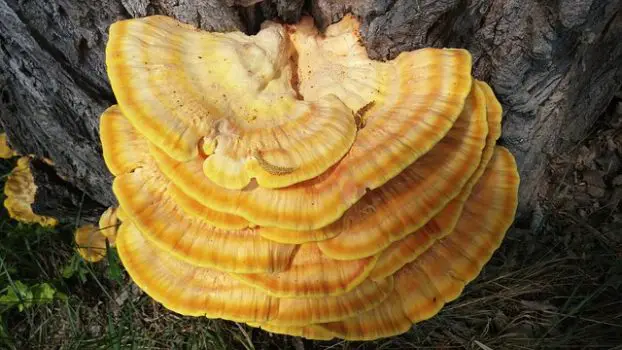Colony Collapse disorder is wreaking havoc on honey bees worldwide. One of the components to this collapse is believed to be the effect of the Varroa Mite parasite and the viruses it brings.
Several studies have revealed bee behavior wherein portions of mushrooms are brought back to a bee’s respective hive, creating beneficial effects. Studies are ongoing, but the initial observations are that mushrooms are helping the health of beehives and are another weapon in the fight against Colony Collapse disorder.
This article explores the beneficial mushroom/bee phenomenon and how even inexperienced backyard beekeepers can use mushrooms to help out their bees.

What’s the deal with the Varroa Mite anyway?
Varroa mites are a plague to bees and beekeepers. These mites are thought to be one of the major causes of the decline in honey bee health and a major contributor to Colony Collapse Disorder.
Varroa Mites are pericytes. They will ride on a honey bee and constantly ingest the hemolymph, or blood of the bee. They act like mosquitoes or vampires that just don’t quit. Because their mouths pierce into the body of the honey bee these pests also spread viruses that they have acquired from other bees.
Additionally, varroa mites don’t just attach to one host bee, they hop from one bee to another, and can infect several bees with viruses as they go from bee to bee. This can weaken a bee colony quickly if the bees are not able to combat the viruses or rid their colony of the mites.
During the colder times of the year, honey bees slow down and go into their winter mode. They cluster around the queen and vibrate to keep her alive for the next season. In this state not much is happening other than minimal feeding and vibrating of the workers. The workers vibrate to keep the queen warm. When the worker bees are in such close proximity the varroa mites have a heyday. The mites will hop from one bee to another infecting as they go.
As temperatures warm up again, beekeepers are finding that a hive with plenty of honey and beebread (pollen stores) has died. The confusion of what they did wrong leads to an investigation. Much of the time the death of the colony is due to a varroa mite infestation. The bees have fall victim to the little vampire pericytes and the viruses they bring.
Generally, viruses are found in the digestive tract and taken into the individual bee through eating and drinking. Typically the cells in the bee’s digestive tract will be able to handle the virus and destroy it before infection. However, the varroa mite directly pierces into the bee’s circulatory system and infects the bee directly into the “hemolymph” or the blood of the bee.
What viruses do Varroa Mites bring?
The varroa mite has been linked to about 20 different viruses that infect bees. This is still an ongoing study and more information is constantly being added. Viruses were first detected in honey bee colonies in the 1930s. Initially, these viruses were considered rather harmless and just part of the honey bee world. Scientists began to become concerned in the 1980s when the population of varroa mites became more widespread.
Biologists are still in the dark regarding many aspects of bee viruses. A lot of research is being conducted to understand these viruses and their role in how bee colonies function or cease to function. For most of us smaller, or hobby beekeepers it means we lose our prized bees.

Some of the viruses that are being transmitted into the hives are:
Sacbrood:
Sacbrood is a virus that directly affects the brood. The bee larvae are unable to shed their final skin before the pupation stage. Fluid builds up and kills the larva. Every larva that dies from sacbrood has enough virus in it to infect 1000 other colonies (Bailey 1981). Nurse bees generally remove the infected larva in the initial stages of the disease.
Deformed Wing Virus (DWV):
Deformed Wing Virus displays with withered, deformed, and/or shortened wings. Transmission of the virus can be in all stages of development. It will kill pupae. It is strongly associated with varroa mite infestation, and will eventually result in the colony to collapse.
Black Queen Cell Virus:
Black queen cell virus is similar to sacbrood, resulting in the death of the larva. It will leave the queen pupae in a yellow sac like sacbrood that will turn the walls of the queen cell black. This virus is most active and at its high point in the spring when many hives are trying to rear new queens. The evidence of varroa mite infestation is limited, but it can be transmitted by injection from the mite into the host bee.
Chronic Bee Paralysis Virus (CBPV):
CBPV will often affect some of the healthiest colonies in the apiary. This virus can demonstrate in two ways. One is where adult bees tremble and are unable to fly or crawl up the stems of plants. Often, they will cluster, and it will result in death within a few days.
The other way CBPV demonstrates is with adult bees looking greasy, black, and hairless. They will sometimes have a bloated abdomen and dysentery. It will also result in death within a few days as well.
Acute Bee Paralysis Virus Complex (ABPV):
This is a complex of associated viruses that includes Acute bee paralysis (ABPV), Kashmir bee virus (KBV), and Israeli acute paralysis virus (IAPV). These viruses all have similar transmission routes and affect bees in similar life stages. Generally, infected hosts show symptoms in the pupae and adult stages. These viruses are often associated with the deadly varroa mite, and resulting in total colony death.
Acute Bee Paralysis Virus (ABPV):
This virus is directly associated with varroa mite infestation. The virus is transmitted into the jelly of the larva. It is also rapidly transmitted by the piercing bite of the varroa mite to the hemolymph (blood) of the bee. It only takes a small amount of the virus to infect the bee. The colony will dwindle and die within the year.
Kashmir Bee Virus (KBV):
This is the most virulent honey bee virus. When infected through the hemolymph system it results in death within 3 days. When the varroa mite transmits the virus, it is deadly in all parts of the bee lifecycle. Even with smaller infestations of varroa mites this virus will kill the entire colony.
Israeli Acute Paralysis Virus (IAPV):
The IAPV will show symptoms such as darkened hairless adults, shivering wings, progressing to paralysis and death. The virus is deadly even with a small amount of the virus when varroa mites are present in the colony.
Slow Bee Paralysis Virus:
Not found in the United States, but found in Fiji, Western Samoa, England and Switzerland. This virus shows up after about 12 days after infection. It slows the two anterior or fore legs of the bee. It will be deadly to all bees and is transmitted by the varroa mite.
With all of these viruses, ingestion to the digestive tract can result in a smaller attack of the virus. The gut of the bee can either break down the virus, or the cells of the bee gut get replaced quickly resulting in the virus becoming less effective. When the varroa mite pierces the bee and injects the virus directly to the hemolymph system however the bee isn’t able to engage it’s gastrointestinal defense. In these cases, the virus has a direct free reign to the bee and results in full infection.
A great article about these viruses and the varroa mite aspect of them is here.
Where did the idea of Mushrooms and beehives come from?
Some years ago, a mycologist named Paul Stamets was watching his bees gathering drops of liquid from mushrooms. He had an epiphany when he postulated that the bees were not gathering sugary fungus drops, but that they were medicating themselves with something found in the mushrooms.
Stamets involved Walter Sheppard, the chair of the Entomology Department at Washington State University. Since that time the two have been testing various mushrooms and their effect on honey bees.
Stamets and Sheppard have found an 800-fold decrease in the amount of viruses present in controlled experiments. That’s amazingly good news to hear in the battle against the varroa mite and the infection of viruses from them.
Stamets is still researching the effects of this on honey bees throughout the winter and in other conditions. He also needs to get the ok from the U.S. Department of Agriculture. His findings are exciting and show some very good promise.
Stamets has been keeping the public apprised of his research efforts. He has had 3 updates to his research. The most recent update can be found here.

Will mushrooms help the small apiary and backyard beekeeper?
Though to date, no commercial mushroom product has been made available for beekeepers to use, there are several ongoing research projects with this end in mind.
It is of interest that there are two varieties of mushroom that have shown good results. These are the Amadou and the Reishi mushrooms. Perhaps it could be helpful to have some of these mushrooms available to your honey bees. You may even observe the similar behavior of bees gathering mushroom juice for the hive.
Where can I get these mushrooms?
Growing mushrooms is an entire other blogpost. I will address it in a post soon. I have grown mushrooms in the past and loved them. They are easily propagated and if you raise them correctly you can keep them reproducing well. I will add resources and sources for these mushrooms when I get our resource page up and running on our website.
Summary
In summary, the devastation of the varroa mite on the honey bee is immense. Varroa mites are extremely effective at spreading deadly viruses directly into the bee’s bloodstream resulting in high infection and death of honey bee colonies. There are many people working to slow and stop the death of all these honey bee colonies. Colony collapse disorder is affecting the food supply of the entire world and could have some rather drastic results.
The use of mushrooms specifically the mycelium, or vegetative part of the mushroom, could help. As research is still forthcoming, I suggest growing some Amadou and Reishi mushrooms near your bees. The mushrooms have been seen to have a very beneficial effect on viruses found in honey bee colonies. When I hear of a product made from the mycelium of the Amadou and/or Reishi mushroom I will for sure post it and make it available through my resource page.
